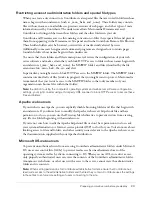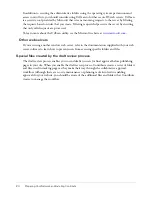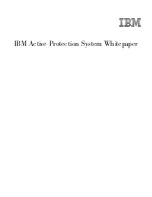
Common website configurations
9
CPS integrates with the organization’s LDAP service, which authenticates user access to various
network resources. In this case, the LDAP authentication is the first step in granting access to
websites hosted on various servers within the organization. The Contribute roles further define
user privileges within a website, determining the degree to which users can modify pages within
the site.
Common website configurations
Before you deploy Contribute, you should consider various scenarios for setting up Contribute
for large or multi-team organizations.
This section describes three primary configurations for you to consider as you set up a Contribute
site.
Single website on one webserver
Typically, this is a website where users have read access to
the root of the site and read/write access to specific folders in the site as controlled by the file
server or network permissions. There is a single root folder and all users access the site using
the same Contribute connection. If this applies to your site, see
“Deploying Contribute for a
single website with one webserver” on page 10
.
Multiple websites on one webserver
In this structure there is a single root folder. The root
folder contains folders for each section or organizational function within the website.
Contribute roles are used to control user access to particular folders on the site and to assign a
subset of the common templates used on the site. Although not required, file server
permissions are usually used in addition to Contribute roles to restrict user access to sections of
a site. If this applies to your site, see
“Deploying Contribute for multiple websites on one
webserver” on page 12
.
Website on a staging server and a live server
Many websites use a staging web server with
their production web server. Staging servers let you create and test web content without
making it live on your public facing website. Only when content has been approved are web
pages and their associated files copied from the staging to the production web server. When
used with Contribute, a staging server adds an extra measure of security because you can
configure your staging server so that Contribute specific files (such as administrative folders,
rollback files, and interim drafts) are not copied to the publicly accessible website outside your
network firewall. For more information, see
“Deploying Contribute to a staging server and a
live server” on page 14
.
Depending on how your website is structured, you need to use separate strategies to successfully
set up Contribute for multiple users and groups. Specifically, you’ll need to think about where to
store the Contribute shared settings file, how to prevent overlapping connection paths, and how
you’ll send connections to users.
Deploying Contribute for a single website with one webserver
In this example, Contribute is deployed to a simple intranet consisting of a single web server
hosting a departmental website. The website has a single, common root folder with subfolders for
individual departments. The site uses Dreamweaver templates and CSS styles to enforce the look
and feel of the website and SSIs to maintain page elements such as navigation menus, headers,
and footers.










































